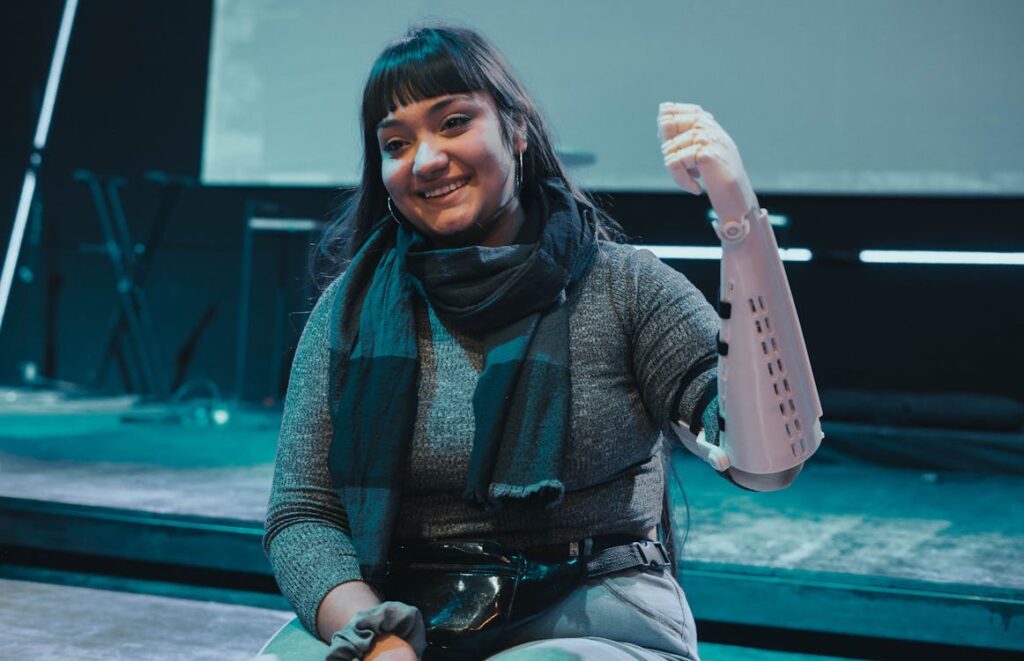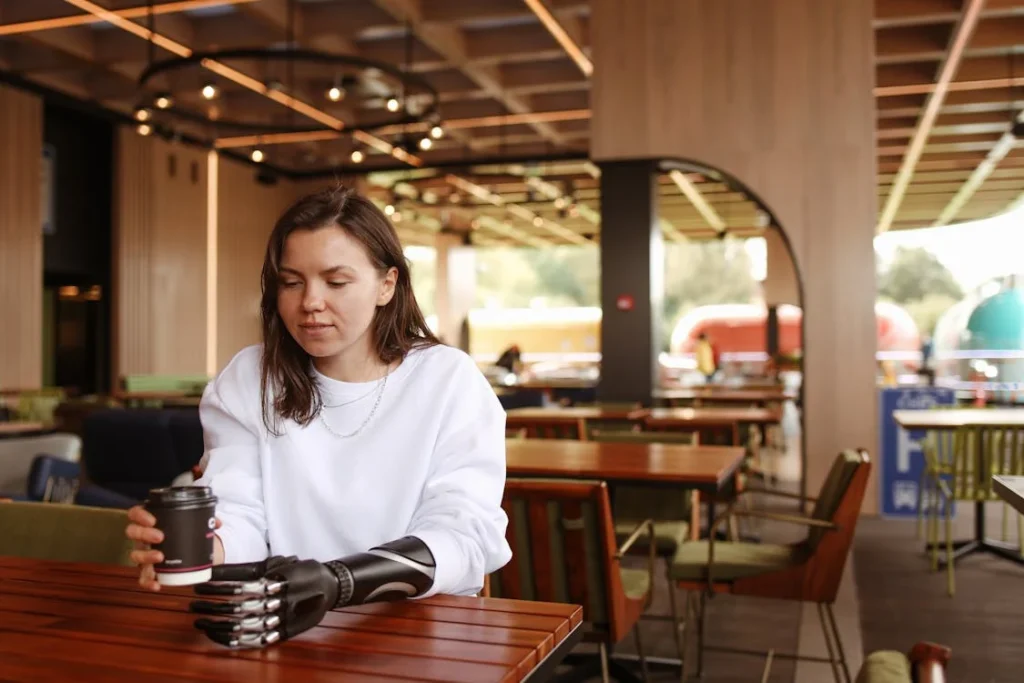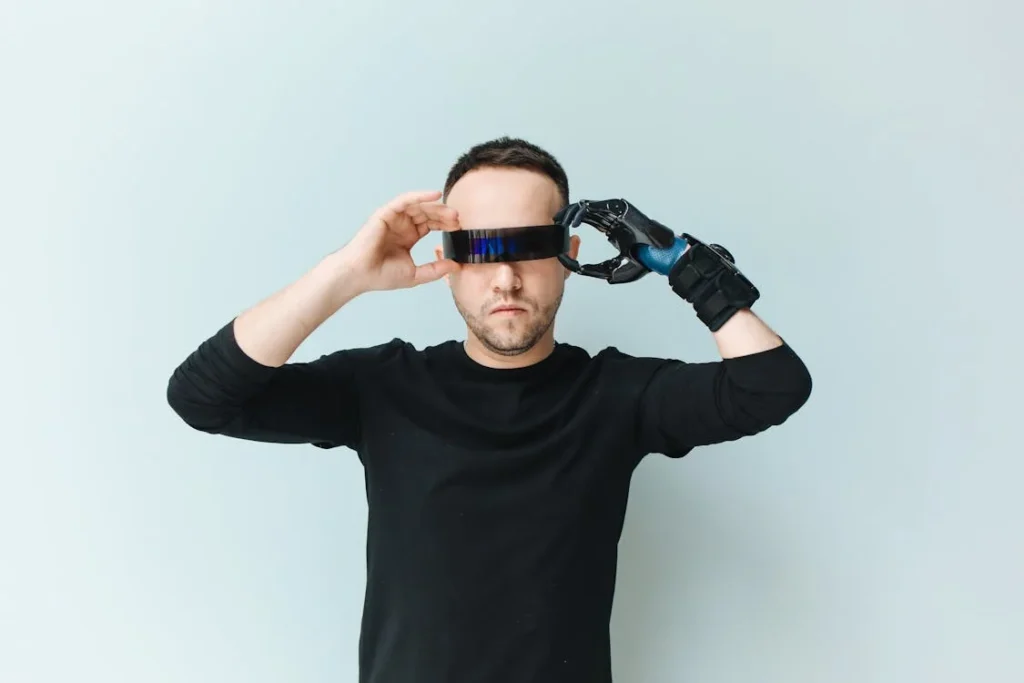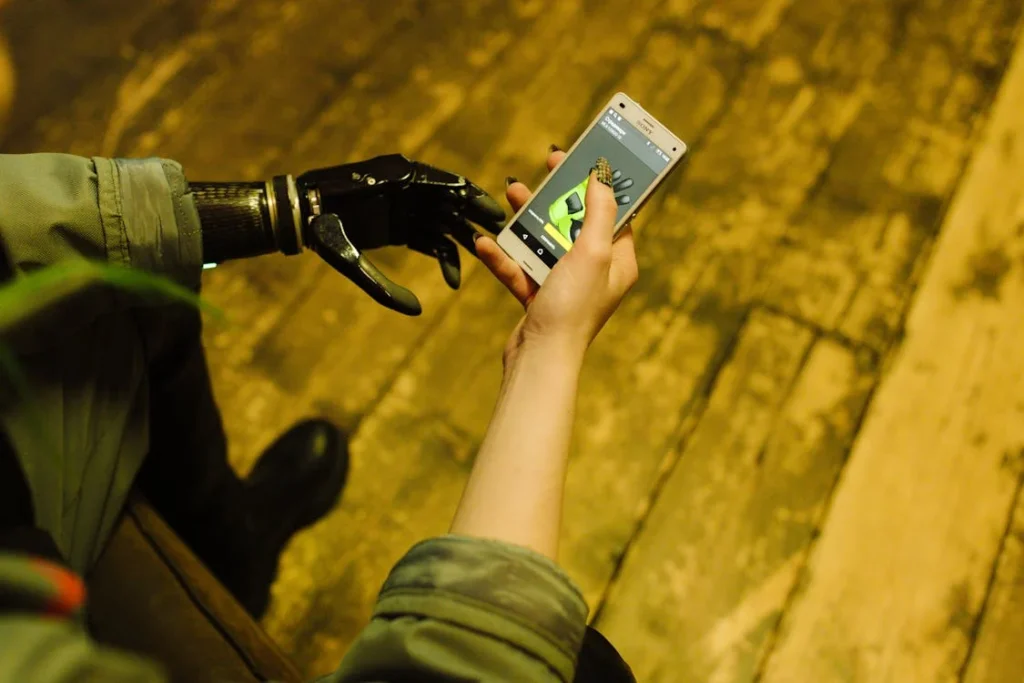When someone loses a hand, life changes in a way most people can’t imagine. Simple things like tying shoelaces, opening a water bottle, or even holding a pen can suddenly feel like climbing a mountain. But technology has come a long way, and today, people don’t have to live without function or independence. At Robobionics, we’ve seen lives transformed because of one powerful invention: the bionic hand.
If you’re living in Meerut or nearby and searching for the best prosthetic hand that truly works like a real one, this article is for you. We’re not going to bore you with technical jargon or complicated terms. Instead, we’ll have a conversation. A real one. Just like we do with every person who walks into our centre.
You may have heard of bionic hands before. Maybe you’ve even tried one. But here’s the truth—not all bionic hands are made equal. And not all companies understand the unique needs of someone living in Meerut, trying to rebuild life with a prosthesis. That’s where we come in.
Robobionics is proud to be at the forefront of bionic prosthetics in India. We’re not just a company that makes robotic hands—we’re people who care deeply about how these hands change lives. We know every person is different, every limb is different, and every goal is different. So our approach? One that starts with the human side of the story, not just the hardware.

Understanding Life After Limb Loss in Meerut
Losing a limb is not just a physical change—it shifts every part of life. In a city like Meerut, where people work hard, raise families, and depend on themselves every day, the journey after limb loss comes with its own challenges.
But with the right prosthetic solution, it’s possible to move forward with strength, dignity, and confidence.
What Daily Life Looks Like After Losing a Hand
Imagine waking up in the morning and reaching for your toothbrush—but it slips from your grip. Or pouring tea, but struggling to hold the kettle steady.
For many people in Meerut who have lost a hand, these daily experiences can feel like barriers. Things that were once second nature now take extra effort or feel frustrating.
You don’t realise how much you rely on your hands until one of them is gone. You use your hands for dressing, cooking, writing, working, and even just holding someone you love.
When that function is lost, it’s not just about the physical task—it can affect your self-confidence and your sense of identity.
Many people in Meerut are manual workers, farmers, shopkeepers, electricians, or operate machinery. Their work depends on physical ability. So, when they lose a limb, it’s not just a personal loss—it can mean the loss of income and purpose.
Students may struggle in school without the ability to write or draw. Homemakers may find it hard to do tasks that used to bring joy. The emotional weight of this change is often heavy, and it’s not something to be taken lightly.
But this is where technology can play a healing role. A well-designed bionic hand doesn’t just restore movement—it restores freedom. The ability to live without constant dependence. The power to feel capable again.
Why Traditional Prosthetics Often Fall Short
Now, you might think: “There are many prosthetics available. Why is a bionic hand any different?” That’s a fair question. Let’s talk about it.
Traditional prosthetics—especially the mechanical ones—are built for basic use. They look like a hand, maybe even feel like one, but they don’t work like one. They might be heavy, hard to use, and limited in motion.
Some are made with generic sizing and fittings, making them uncomfortable over time. Most require a lot of effort to perform even the simplest task, like holding a spoon or buttoning a shirt.
The problem with these older models is they treat the symptom, not the experience. They give you something to fill the space, but not something that feels alive. And for someone rebuilding life in Meerut, settling for “just okay” isn’t good enough.
That’s where bionic hands come in. And not just any bionic hands—ones built by a team who knows what it means to build for real life, not just for labs or showrooms.
The Rise of Bionic Technology in India
India has always been a country of innovation, and in the last decade, bionic technology has taken a big leap forward.
What used to be only available in foreign countries at very high prices is now being developed right here—by Indian engineers, doctors, and designers who understand the unique needs of Indian users.
Meerut is a growing city, with access to better healthcare and technology than ever before. This progress has opened doors to advanced prosthetics like never before. But among the few players in the Indian bionics space, one name continues to stand out: Robobionics.
We didn’t just jump into the industry because it was growing. We got into this work because we saw a gap—between what users needed and what they were being given.
We saw that people wanted more than a tool. They wanted a real hand that could adapt to their lifestyle. That could help them do more than just survive—but thrive.
What Makes a Bionic Hand Truly “The Best”?
A bionic hand isn’t just a robot attached to your arm. It’s a carefully designed piece of technology that mimics human movement using sensors, motors, and intelligent design.
But here’s the thing—having advanced features isn’t enough. What matters is how those features fit into a person’s life.
The best bionic hand isn’t just the one with the most buttons or the fanciest grip styles. It’s the one that works seamlessly, naturally, and reliably. It’s the one that:
- Responds to muscle signals with speed and accuracy
- Feels light, balanced, and comfortable for all-day use
- Can handle real objects like utensils, tools, books, and phones
- Is strong enough to lift weight, but delicate enough to hold an egg
- Has a design that looks modern, not bulky or artificial
- Comes with real-time support and guidance for use
And most importantly—it should be affordable. In a city like Meerut, where people come from all walks of life, cost matters. People need value for money, not just a flashy product.
Robobionics has spent years fine-tuning every detail of its prosthetic hands to tick these boxes. But we also add something extra: a human touch. We walk with you through the entire process—from the first consultation to the final fitting and beyoWe’ve helped hundreds of people across India—and right here in Meerut—get back to doing the things they love. Not just in theory, but in daily, practical life.
We’ve seen kids go back to school. Farmers return to their fields. Artists start drawing again. Parents holding their children with two hands. That’s the kind of impact we work for.

Why Robobionics is the #1 Choice for Bionic Hands in Meerut
When someone in Meerut needs a prosthetic hand, the market can feel overwhelming. There are imported options, local fabricators, hospitals recommending different models—and everyone promises they have the “best.”
But at Robobionics, we don’t just say we’re the best. We prove it—through real results, human connection, and meaningful outcomes.
Built by Experts, Driven by Empathy
Robobionics was not built as just a technology company. It was built with people in mind first. Our team includes some of India’s finest biomedical engineers, prosthetics experts, rehabilitation specialists, and experienced technicians.
But beyond their skills, what makes them stand out is their heart.
We don’t build devices—we build second chances. We know that a bionic hand is not just a tool. It’s an extension of someone’s identity.
That’s why every single prosthesis that leaves our workshop is custom-crafted, thoroughly tested, and fitted to the unique needs of the person who will wear it.
From the start, our mission has been to close the gap between medical-grade technology and everyday human needs. And we’ve succeeded because we’ve never lost sight of one thing: people come first.
We speak in your language, understand your culture, and listen to your worries. We meet you where you are—not in some sterile showroom, but in your real life. And we’re proud that our presence in Meerut has brought hope to families, workers, students, and elders who thought their independence was lost forever.
Real Feedback From Real People in Meerut
One of the most powerful ways to know if a company delivers on its promise is through the stories of people who’ve used the product.
In Meerut, we’ve worked with a wide range of individuals, from teenage students to senior citizens. And their words tell the story better than any brochure can.
There’s Meena, a schoolteacher who lost her right hand in a traffic accident. Her biggest fear wasn’t how she’d cook or clean—but how she’d write on the blackboard again.
With the Robobionics hand, she’s back in the classroom. And her students barely notice any difference. “It’s not just a machine,” she said. “It gave me my job and my joy back.”
Then there’s Iqbal, a young man who worked in a car garage. A workplace accident cost him his hand. For months, he stayed home, feeling hopeless.
Then he discovered Robobionics. Today, he’s using his bionic hand to handle tools, tighten bolts, and even wash vehicles again. “It feels like a real part of me,” he says with pride.
These are not exceptions. These are the results we see every day.
We Design With India in Mind
Many international prosthetic companies offer solutions in India. But here’s the problem—they’re designed for Western users. That means they’re built for different lifestyles, climates, and economic realities.
They might work well in controlled environments, but not necessarily in the everyday Indian setting.
Robobionics is different. Our hands are built in India, for India. We understand that in cities like Meerut, a bionic hand needs to be:
- Durable against dust, heat, and humidity
- Easy to maintain without frequent servicing
- Strong enough for manual tasks but gentle for delicate ones
- Affordable without compromising quality
This local understanding shapes everything we do—from material selection to software programming. Our bionic hands are tested in real-world Indian conditions, so when you get one, you can trust it will handle your life, not just your clinic visit.
Personalised Fitting and Ongoing Support
One of the biggest reasons people feel disappointed after getting a prosthesis is poor fitting. A device may look great on paper but can cause discomfort, skin issues, or improper balance if not fitted correctly.
At Robobionics, we never cut corners on fitting. We use 3D scanning, precise socket crafting, and comfort-based testing to ensure your prosthetic hand feels like it belongs to you. And our care doesn’t stop there.
We provide in-person and virtual support, tutorials for training, and regular check-ins to make sure your hand is doing what it’s supposed to. If there’s ever an issue, we respond quickly—because we know how important your daily routine is.
And if you live in Meerut and need an adjustment, repair, or even just a conversation, our regional team is always within reach.
How We Keep Our Bionic Hands Affordable
Many people assume bionic hands must cost several lakhs—and in many places, that’s true. Imported hands, in particular, come with heavy price tags that most Indian families can’t afford.
But Robobionics has changed the game.
We’ve streamlined our manufacturing, avoided middlemen, and invested in cost-effective materials without sacrificing performance. That means we’re able to offer our hands at a fraction of what international brands charge.
We also assist with medical reimbursements, government schemes, and EMI options, so no one is left behind due to money.
We believe everyone deserves dignity, not just those who can pay top prices.
Why People Say “It Feels Like My Hand”
Technology is impressive, but it means nothing if it doesn’t feel right. The feedback we hear most often from our users in Meerut is this: “It feels like my real hand.”
That’s the highest praise we could ever get. It means we’ve succeeded—not just in building a great product, but in restoring something even greater: a sense of self.
Our hands respond to your muscle signals. They react smoothly. They grip with care. And they give back the rhythm of movement that once felt lost. Whether it’s tying your shoelaces, driving a scooter, holding your child, or writing your name—you’ll feel like you again.

How to Choose the Right Bionic Hand in Meerut: A Step-by-Step Guide
Choosing a bionic hand is not just a decision—it’s a turning point. For someone in Meerut who has never used a prosthesis before, or for someone looking to upgrade from a basic one, the process can feel a bit overwhelming at first.
At Robobionics, we make it simple. Not by dumbing it down, but by guiding you through every step, patiently and clearly. In this section, we’ll help you understand what you need to look for, what to avoid, and how to make a confident choice that supports your life.
Start With Your Daily Needs
Before looking at models, specs, or even price, ask yourself one simple question: “What do I need this hand to help me do every day?”
This question might seem obvious, but it’s powerful. Your daily life in Meerut might include working with tools, cooking for a family, lifting items at a shop, or taking care of children.
For students, it might be writing notes, handling books, or using a computer. Some may need to carry heavy things. Others just want the comfort of being able to button a shirt or hold a glass.
The right bionic hand should match these needs—not force you to adjust your life to it.
At Robobionics, we begin every consultation by simply listening. We ask about your routine, your job, your hobbies, and your goals. Based on that, we recommend options that fit you, not just the product line.
Don’t Be Fooled by “Fancy” Features You Don’t Need
Some companies will try to impress you with long lists of features. You’ll hear terms like “multi-articulated fingers,” “adaptive grip control,” or “custom gesture programs.” These are real features, but you have to ask—do you need them?
There’s a big difference between a hand that looks impressive on paper and one that actually helps in real life. If the hand has 15 grip modes but you only ever use 3, the extra ones don’t matter.
If the battery needs constant charging, or the hand breaks easily, even the most advanced tech becomes a burden.
That’s why at Robobionics, we keep it practical. We make hands that are smart, yes—but also tough, reliable, and made for daily use. Our design philosophy is simple: it should do what you need, without confusion.
We also provide in-person demos for people in Meerut, so you can feel the hand in action before you commit. It’s one thing to read about it, but when you see it respond to your muscles, something just clicks.
Comfort Is King: Fit Matters More Than You Think
One of the most overlooked parts of choosing a prosthesis is how it fits on your arm. Even the best bionic hand won’t help if the socket—the part that connects the hand to your limb—is uncomfortable or doesn’t sit right.
That’s why at Robobionics, we put extra care into the fitting process. Using advanced 3D scanning and molding, we design sockets that fit your shape, not some standard template. We adjust based on bone structure, skin sensitivity, sweat, weight distribution, and more.
We know Meerut gets hot in summer. That’s why our materials are breathable, light, and made to handle sweat and friction. We offer different liners, cushioning, and fasteners based on your needs. And we always test fittings carefully before the final assembly.
When your prosthetic hand feels like it belongs, you use it more. You trust it. You forget it’s even a device—and that’s when real healing begins.
Understand the Technology—Without Needing a Degree
Let’s talk quickly about how bionic hands work, in simple terms.
Our hands use small electrical signals that your muscles naturally produce when you try to move. Even after losing a hand, the muscles in your forearm still fire when you try to grip or release.
Sensors in the socket pick up those signals and send them to the hand’s motor, which then opens, closes, or moves the fingers.
It all happens in less than a second—and it feels surprisingly natural after some practice.
At Robobionics, we teach you how to use it. We give you time to train, adjust, and build confidence. There’s no pressure. Our specialists guide you gently, explain everything in simple words, and make sure you’re not left guessing.
This technology may seem complex from the outside—but using it doesn’t have to be. And that’s our promise.
What About Battery Life, Charging, and Maintenance?
This is a common concern for many people in Meerut. “Will I have to charge it every few hours? What if something breaks? Will I be able to fix it easily?”
We hear you. And we’ve built answers into our design.
Robobionics bionic hands come with long-lasting rechargeable batteries. On a single charge, you can use the hand throughout the day for regular tasks.
Charging it overnight, just like your phone, is usually enough. And our battery ports are placed safely and accessibly, so you don’t have to remove the whole hand just to recharge it.
As for maintenance—our hands are built to last. But like any device, occasional servicing may be needed. That’s why we have dedicated support in Meerut and nearby areas.
If anything needs fixing, we make sure you get it quickly and affordably. No long waits, no sending the hand abroad, no expensive replacements.
We also provide a simple care guide so you can keep the hand clean, functional, and in great shape with basic steps at home.
Support Doesn’t End After You Get the Hand
Here’s something that sets us apart: we’re not done once you leave with your prosthesis. We follow up. We check how you’re doing. We answer calls, offer free adjustments, and help you build confidence.
Sometimes, all you need is someone to say, “You’re doing great. Let’s tweak this setting and see how it feels.” We’ve built our company culture around that kind of support.
For those in Meerut, we even offer local training sessions, either one-on-one or in small groups, so you’re never alone in your journey. You become part of the Robobionics family—and we take that seriously.

Robobionics vs Other Prosthetic Providers: What Really Sets Us Apart
Choosing a bionic hand is a major decision—not just financially, but emotionally and physically too. It’s a commitment to start fresh, to try something new, and to trust a brand to help rebuild your life. So it’s fair to ask: “Why should I choose Robobionics over other prosthetic providers?”
Let’s answer that clearly, without hype or hard selling. Because at Robobionics, we believe transparency and trust go a long way. We’re here to earn your confidence—not by making big claims, but by showing you what really makes us different from others in the market.
Designed for India, Not Just Imported Into It
Many prosthetic companies operating in India are actually distributors of foreign-made hands. These hands are built with good intentions, no doubt, but they’re often made for users in Europe or North America—places where the climate, lifestyle, and daily needs are completely different from those in Meerut or anywhere in India.
That mismatch becomes a problem. We’ve seen imported hands struggle with our heat and dust. We’ve seen users frustrated by software that isn’t optimised for Indian muscle signals.
We’ve seen hands that break under pressure simply because they weren’t made to handle the kind of daily work Indian users do.
Robobionics, on the other hand, is made right here in India, by Indians, for Indian users. That’s not just a line—it’s our core advantage. We build for the conditions our users face.
Whether you’re using the hand at a roadside stall, a workshop, a farm, or in a school, we make sure it holds up. Our testing isn’t done in labs alone—it’s done in real-life Indian settings, including with our users in Meerut.
We also ensure that our design reflects Indian aesthetics—simple, functional, and dignified. You won’t find oversized, toy-like designs or robotic-looking fingers. Our hands are sleek, elegant, and look professional—so you feel proud wearing them.
We Believe You Deserve More Than a Product—You Deserve a Partner
Most companies sell prosthetics like gadgets: You buy it, get a short demo, and then you’re on your own. But life doesn’t work like that. Especially when you’re adjusting to a new limb, you’ll have questions, face small challenges, or need to build confidence over time.
That’s why Robobionics never leaves you alone. When you choose us, you don’t just get a product—you get a support system. We become your partner for the long run.
Whether you need help with the hand itself, or simply someone to talk to when you’re feeling unsure, our team is always there.
We also connect you with other users. Through support groups, local meetups, and feedback sessions, you can share your journey, ask questions, and inspire others who are on the same path.
In Meerut, we’ve helped create a small but growing community of bionic hand users who now motivate each other. That’s the kind of impact we’re proud to make.
Customisation That Truly Feels Personal
Every human arm is different. Every muscle behaves differently. Every limb loss is unique. But many providers use standard-sized sockets or “close enough” designs. The result? A hand that doesn’t fit well, doesn’t respond quickly, or feels uncomfortable to wear.
At Robobionics, we take personalisation seriously. Our custom-fitting process involves detailed 3D mapping of your residual limb. We study your muscle movement patterns. We ask about your daily activities. And we build the prosthetic around you—not the other way around.
We also offer different surface finishes, skin tones, and functional options. If you want a hand that blends in with your skin, we can do that.
If you want something that stands out—metallic, matte black, or even custom coloured—we can do that too. Because how you feel wearing your hand matters just as much as how it works.
This level of personalisation is rare, especially in prosthetics. But we offer it as standard—because comfort, confidence, and control should never be optional.
In-Person, Localised Support in Meerut
One of the biggest pain points with other providers is distance. You get your prosthetic hand in Delhi or Mumbai, but when something goes wrong, you’re told to travel again—or worse, ship it back.
We knew that wouldn’t work for our users in Meerut.
That’s why we’ve built regional support infrastructure. Our trained partners in Meerut can assist with fittings, minor repairs, training, and guidance.
We also offer home visits and remote video sessions if you’re unable to travel. For anything more complex, our main service centre provides fast turnaround support without the long delays or red tape.
We understand how difficult it can be to travel with a disability. So we bring the help to you whenever we can.
Our Pricing Is Honest, Transparent, and Accessible
Let’s talk money, honestly. Many prosthetic providers shy away from talking about price until the last step. Or worse, they lure you in with a low base price—then add hidden fees for features, fittings, servicing, and training.
We don’t do that. When you talk to us, we tell you exactly what you’ll get and what it will cost. We don’t upsell you things you don’t need. We don’t push you into overpriced packages. We build a solution that fits your budget and goals.
And because we manufacture our own hands, we avoid the markups that come from importing devices. That saving goes directly to you.
We also help with:
- EMI options for easier payment plans
- Documents for government reimbursement schemes
- NGO or CSR tie-ups for financial assistance (in special cases)
We believe cost should not be the reason someone gives up on a better life. And we fight hard to keep our pricing fair, without sacrificing the quality you deserve.
We Don’t Just Innovate. We Care.
It’s easy to say “we’re the best.” It’s harder to prove it every day through action. At Robobionics, we’ve earned the trust of our users not because of marketing—but because we care. We listen to our users. We learn from them. And we continue improving our technology based on what real people need.
Every update, every design choice, every service improvement is made with one goal: to make your life easier, better, and fuller.
And that’s why, when people in Meerut ask around for the most trusted name in bionic prosthetics, one name keeps coming up—Robobionics.

The Step-by-Step Journey with Robobionics: From Consultation to Confidence
Getting a bionic hand is not just a purchase—it’s a journey. One that takes you from uncertainty to confidence, from hesitation to freedom.
At Robobionics, we’ve designed every step of this journey to be smooth, supportive, and stress-free. Whether you’re in Meerut or nearby, our process is built to respect your time, your needs, and your pace.
Let’s walk you through exactly what happens when you reach out to us—from the very first call to the moment you use your new hand with confidence.
Step 1: Your First Conversation with Us
Everything begins with a simple chat. You can call us, message us, or walk into one of our partner centres near Meerut. No formal referral needed. No pressure. Just a conversation.
During this first discussion, we ask a few questions:
– What kind of limb loss do you have?
– How long ago did it happen?
– What are your goals with a prosthetic hand?
– What’s your daily life like—your work, your hobbies, your challenges?
These questions aren’t just formalities. They help us understand what kind of solution would actually work best for you. Because no two users are alike, and no one deserves a one-size-fits-all approach.
We also explain the entire process clearly. We’ll tell you what options are available, what they cost, and what to expect at every stage. Most importantly, we listen. And we never push you into any decision.
Step 2: Clinical Assessment and Muscle Testing
Once you’re ready to take the next step, we schedule a clinical assessment. This can be done at our facility or through one of our local prosthetic partners in Meerut.
During this session, we do a thorough evaluation of your residual limb. We check the shape, skin condition, and most importantly—your muscle activity.
Even after limb loss, your forearm muscles still fire when you try to move your “missing” hand. We use advanced sensors to detect these signals and assess how well they can control a bionic hand.
This step helps us decide the best type of control system for you. Some users have strong, clear signals. Others may need a bit of muscle training first. Either way, we’ll guide you with patience and care.
We also take measurements and photographs for designing the socket and selecting the ideal hand model.
Step 3: Socket Design and Fitting
The socket is the most important part of the prosthesis. It connects your body to the device. If the socket is not right, even the best hand won’t feel right.
That’s why we use 3D scanning and modern modeling tools to create a socket tailored to your exact limb shape. We test multiple liners and materials to see what gives you the best comfort. You get to try it on before we finalise anything.
We check:
– Is it snug but not tight?
– Does it cause any pressure or irritation?
– Can you wear it for long hours without discomfort?
If any adjustments are needed, we make them. Our goal is for you to forget you’re even wearing it.
Step 4: Choosing the Right Hand and Features
Next, we select the bionic hand unit that will be attached to your socket. Depending on your needs, we might recommend a single-grip myoelectric hand or a multi-grip model with smart functionality.
We also show you how each option works. You’ll be able to try sample units in person. Some clients even choose special designs—like carbon-fiber shells or coloured finishes. Others prefer a skin-tone look.
We explain battery options, grip patterns, software updates, and accessories—all in simple words. There are no hidden add-ons or upsells. Just clear, honest guidance to help you choose what’s right for you.
Step 5: Training and Muscle Control Practice
Once your hand is built and fitted, we don’t just hand it over and wish you luck. We train you—step by step.
Training usually starts with muscle control. You’ll learn how to “think” the right signals so the hand responds naturally. This might feel strange at first, but it becomes second nature with just a little practice.
You’ll learn how to:
– Open and close the hand
– Switch grip patterns (if using a multi-grip hand)
– Hold light and heavy objects
– Use it for real-life tasks: eating, writing, picking up your phone, etc.
Our training sessions are relaxed and friendly. If you’re in Meerut, we can do them locally. We take the time to make sure you’re comfortable, confident, and ready.
Step 6: Real-World Use and Feedback
Once you start using your hand in daily life, things might feel a bit unfamiliar at first. That’s totally normal. You might notice certain grips feel easier than others, or that your muscles need some adjustment time. That’s where our ongoing support kicks in.
We check in with you regularly. We ask what’s working, what’s not, and what could feel better. If the hand needs a setting change or if the socket needs a small tweak, we take care of it—fast and free.
We also celebrate your victories. When you tell us, “I tied my shoelaces today for the first time in months,” we celebrate right along with you. Every milestone matters.
Step 7: Long-Term Support and Upgrades
We’re here for the long haul. Your hand will evolve with you. If you later want to upgrade to a multi-grip version, or if you want to add a waterproof cover or get a new socket design, we’ll make it happen.
We also offer annual checkups, minor servicing, and new software updates. And if anything goes wrong, we fix it quickly—because we know how important your hand is to your daily life.
With Robobionics, you’re never alone. From your first call to your first handshake with your new hand—we’re with you every step of the way.

The Emotional Journey of Regaining Independence with a Bionic Hand
Beneath the surface of technology, wires, sensors, and silicone lies something far more powerful—emotion. For most people in Meerut who come to Robobionics, it’s not just about getting a hand that works.
It’s about reclaiming a part of themselves that felt lost. And that journey, though personal and different for everyone, carries similar moments of fear, doubt, hope, and finally, triumph.
Life Before the Prosthesis: Quiet Struggles and Invisible Fears
Before someone decides to take the step toward a bionic hand, there’s usually a long period of hesitation. It might be weeks, months, or even years.
Some people have gone through surgeries, hospital stays, and the emotional weight of loss without saying much to others. Outwardly, they’re coping. Inwardly, they’re carrying a storm.
Many in Meerut find ways to adjust with their remaining hand or by depending more on family. But that dependence can take a toll—mentally and emotionally.
A young man may feel uncomfortable asking for help with basic tasks. A mother may feel guilty that she can’t care for her child the way she used to. A student may lose the confidence to go back to school. These are quiet struggles, often hidden behind a brave smile.
At Robobionics, we’ve spoken to people who didn’t step out of their house for months because of how self-conscious they felt. We’ve seen adults break down in front of us—not because of the loss, but because of how deeply they miss the simple joys of independence.
That’s where the emotional journey begins. Not with the hand itself—but with the decision to believe that change is possible.
The First Spark: Hope Replaces Hesitation
The first time someone sees a bionic hand move with their own muscle signals, something shifts. It’s not about the technology. It’s the feeling that maybe, just maybe, life doesn’t have to stay this way.
The moment the fingers open and close in response to a thought, the hesitation begins to melt. We see people smile, cry, laugh—all in that first moment of connection.
This spark of hope is powerful. It brings a kind of energy that helps people start imagining what they can do again. Could they go back to work? Could they hold a pen again? Could they cook for their family or ride a bike?
This is when confidence starts to grow, not because the hand is perfect from day one, but because it represents a new beginning.
At Robobionics, we don’t just fit the prosthetic and move on. We stay with our users in that emotional space. We encourage them to explore. We listen to their fears. And we celebrate every small success with genuine pride.
Rebuilding Confidence, One Day at a Time
The first few days with a bionic hand are often filled with learning. The hand responds, yes—but building full control takes practice. There might be moments of frustration when something doesn’t work right away. And that’s okay. Because this journey is not about speed—it’s about transformation.
Users in Meerut often tell us that one of the hardest parts isn’t learning to use the hand, but learning to trust themselves again.
They’ve spent so long adjusting to limitations that freedom can feel unfamiliar at first. But with every successful action—tying a knot, peeling a fruit, turning a doorknob—the confidence grows.
We’ve watched individuals who couldn’t lift a spoon begin to eat independently again. We’ve seen men return to their jobs, students ace their exams, and parents hold their children with both hands for the first time in years.
These moments may look small from the outside, but inside, they carry the weight of victory.
Owning the Identity: From “Disabled” to “Empowered”
There’s a shift that happens after someone begins to use their bionic hand regularly. At first, they may try to hide it, covering the device with sleeves or gloves, not wanting to draw attention. But over time, something remarkable happens.
They begin to own it.
They stop hiding. They start showing others what the hand can do. We’ve had users in Meerut proudly demonstrate their grip strength, or post videos of their progress on social media. Some even visit our centres to talk to new users, encouraging them with their stories.
The label of “disabled” begins to fade. In its place grows a new identity—one rooted in resilience, adaptation, and strength. These users are no longer defined by what they lost. They’re defined by how they reclaimed it.
This emotional transformation is perhaps the most beautiful part of what we do at Robobionics. It’s not visible in marketing brochures. You won’t see it in tech specifications.
But you’ll see it in the eyes of every user who walks out of our centres standing taller, smiling wider, and moving forward with purpose.
The Ripple Effect on Family and Community
What many don’t realise is that getting a bionic hand doesn’t just change one person’s life—it changes the lives of everyone around them.
Family members who were once full-time caregivers are now free to relax a bit more. Children who looked at their parents with confusion now see them as heroes. Communities that once saw someone as limited now begin to admire their courage.
In Meerut, we’ve seen families come together to support a loved one through their training. We’ve had neighbours visit our clinics out of curiosity and leave inspired. The ripple effect of one person’s transformation touches many, silently breaking the stigma around disability.
That’s the emotional journey—a deeply human experience that goes far beyond robotics. It’s about reclaiming independence, restoring pride, and rediscovering joy.

Conclusion
Losing a hand is life-changing—but so is getting it back, in a new and powerful form. At Robobionics, we don’t just build bionic hands. We help people in Meerut and across India reclaim control, confidence, and dignity. With cutting-edge technology built for Indian lives, compassionate support, and unmatched personalisation, we’re proud to be the name people trust when they’re ready to start fresh.
If you’re in Meerut and searching for the best prosthetic bionic hand, we’re here—ready to listen, guide, and walk with you every step of the way. You’ve already made it through the hardest part. Now, it’s time to move forward, one strong grip at a time.
Because at Robobionics, we don’t just restore hands. We help rebuild lives.



